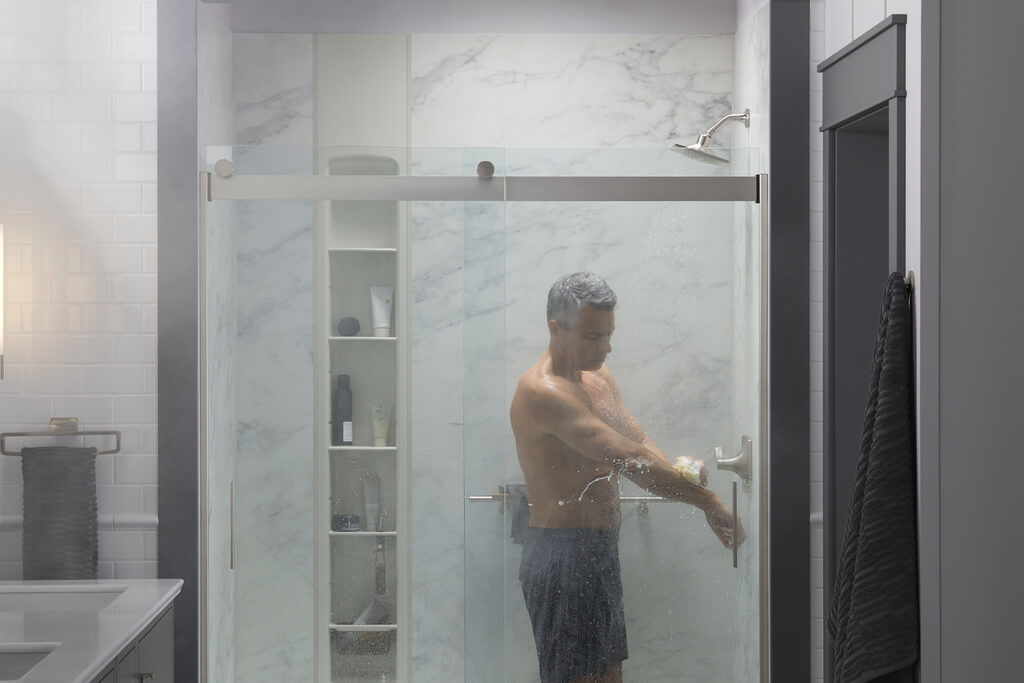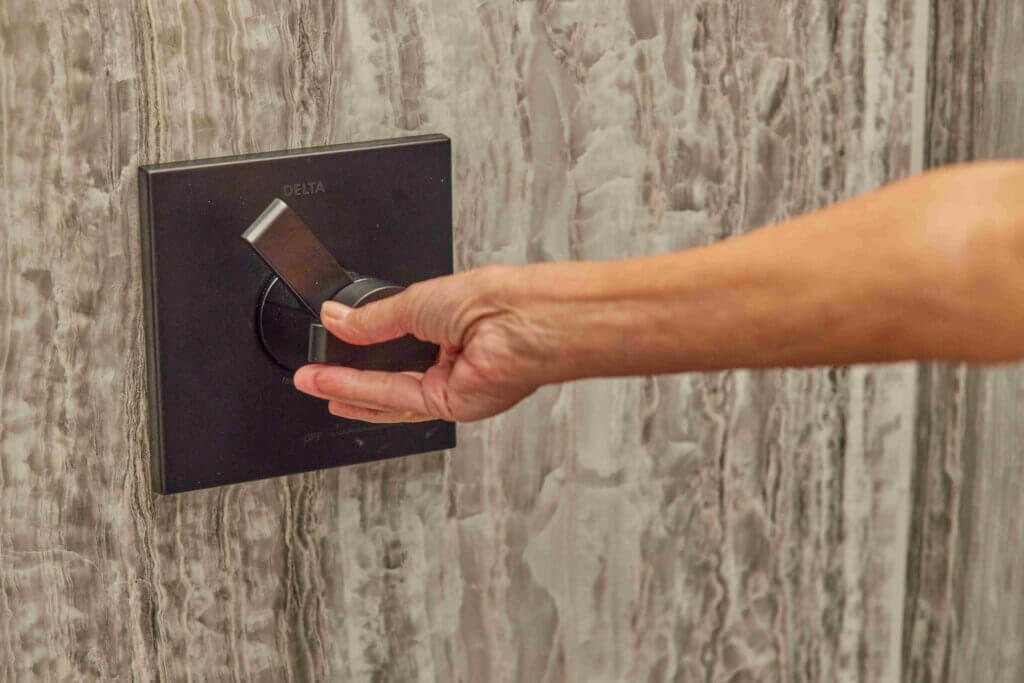Choose the Best Shower Temperature: A Guide to Hot vs Cold Showers

From brisk morning rinses to warm, soothing soaks, the temperature of your shower shapes your daily comfort and your health. But how hot is too hot? Is cold water really better for recovery? In this expert guide, we break down the facts about hot vs cold showers, uncover the ideal shower temperature for different needs, and share expert tips for making the most of your routine.
Plus, we’ll introduce KOHLER technology available along with walk-in baths and LuxStone showers that helps you lock in your best shower temperature safely and reliably every single time.
What Is the Best Temperature for a Shower?
Most dermatologists agree that the best temperature for a shower sits between 98°F and 104°F (37°C–40°C). This range is warm enough to cleanse and relax without stripping away your skin’s protective barrier.
Ideal Shower Temperature by Scenario:
- Wake-up showers: 70°F–85°F (cool)
- Pre-bedtime routine: 100°F–104°F (warm)
- Post-exercise recovery: 55°F–60°F (cold) or 98°F–104°F (warm)
- Sensitive or dry skin: 95°F–98°F (lukewarm)
While this is a helpful framework, the best temperature for a shower really comes down to how your body responds, and that’s where personalization becomes key.
Are Hot Showers Bad for You?
Hot showers aren’t inherently bad, but prolonged exposure to high temperatures (over 105°F) can cause several problems, especially for your skin and hair.
Risks of Overly Hot Showers:
- Skin damage: Heat strips away natural oils, leading to dryness, irritation, and flaking.
- Worsened conditions: Eczema, acne, and rosacea may flare up due to inflammation.
- Scalp & hair issues: Excessive heat opens the hair cuticle, contributing to frizz, dryness, and breakage.
- Circulatory stress: Extended hot showers can widen blood vessels and potentially cause dizziness in sensitive individuals.
That said, a moderately hot shower can still serve important functions, especially for mental relaxation, loosening tight muscles, or easing congestion.
Cold Showers: Benefits and Drawbacks
Cold showers are often touted by athletes and wellness experts for their restorative power—and for good reason.
Benefits of Cold Showers:
- Reduces inflammation: Cold water constricts blood vessels and reduces swelling.
- Boosts circulation: Encourages blood flow to vital organs.
- Improves mood: Triggers endorphin release and increases alertness.
- Strengthens immune function: Studies suggest cold exposure may improve resistance to illness.
Potential Drawbacks:
- Can be a shock to the system, especially for people with heart issues.
- May tighten joints and increase stiffness in colder months.
- Not always ideal for relaxation or pre-sleep routines.
Many people opt for a hybrid approach: warm water for comfort, followed by a brief cold rinse to finish.

Typical Shower Temperature: What Most People Use
Most U.S. adults shower with water ranging between 100°F and 106°F. However, your water heater may push temperatures up to 120°F or higher, which is dangerously hot, especially for children or elderly individuals!
To stay safe:
- Set your water heater to 120°F or below.
- Avoid showers over 15 minutes in very hot water.
- Use a thermostatic or digital valve for consistent control.
Many people unknowingly shower at temperatures higher than what’s considered safe or ideal, especially if the water leaves your skin red or tight afterward.
Hot vs Cold Showers: When to Use Each
Choosing the right shower temperature depends on your body’s needs and the time of day. Below are common scenarios and how different temperatures can benefit you:
- After a workout
- Cold showers: Help reduce inflammation, minimize swelling, and ease post-workout soreness by constricting blood vessels.
- Hot showers: Promote muscle relaxation, increase circulation, and help flush out lactic acid buildup from exerted muscles.
- For skin and hair care
- Warm water: Gently opens pores and lifts away oils without over-drying, making it ideal for cleansing.
- Cold rinse: Closes pores and hair cuticles, sealing in moisture and reducing frizz while adding shine.
- When you’re sick
- Hot showers: Produce steam that opens nasal passages, soothes muscle aches, and helps with congestion.
- Cool showers: May help reduce mild fevers, but water that is too cold can trigger chills and elevate core body temperature.
- Before bed
- Warm showers: Improve circulation to the skin and help lower core temperature afterward, signaling the body to wind down and promoting deeper sleep.
- To wake up
- Cold showers: Stimulate the nervous system, boost circulation, and trigger endorphins for increased alertness and energy.
The Science Behind Shower Temperature & Your Body
Water temperature directly affects your physiology in several important ways:
- Thermoregulation: Your body works to maintain an internal temperature around 98.6°F. Water hotter or colder than this forces the body to respond with sweating, shivering, or vessel dilation/constriction.
- Hydrotherapy effects: Alternating hot and cold water—often used in athletic therapy and arthritis relief—can stimulate lymphatic drainage, improve circulation, and support muscle recovery.
- Nervous system impact: Cold showers activate your sympathetic nervous system, while warm showers trigger the parasympathetic (rest and digest) response.
The right shower temperature can either energize or calm you, making it a valuable tool beyond just hygiene.
Expert Tips to Find Your Best Shower Temperature
- Use your wrist—not your hand—to test water sensitivity. It’s a better gauge for safe temperature.
- If your skin turns red, it’s too hot. Tone it down to avoid irritation.
- If you’re shivering or clenching your jaw, it’s too cold!
- Start lukewarm and adjust slowly. This allows your body to adapt without shock.
Frequently Asked Questions (FAQs)
What’s the safest shower temperature for children or seniors?
A maximum of 100°F is typically recommended for children and older adults. Always use anti-scald devices or temperature limiters.
Is it better to shower in the morning or at night?
It depends on your goal. Morning showers (especially cool ones) boost energy, while warm evening showers help you relax and fall asleep faster.
Can cold showers help with depression or anxiety?
Some studies suggest cold showers can stimulate endorphin release and activate mood-regulating brain pathways—but they should complement, not replace, medical treatment.
What’s better after a run: hot or cold shower?
Start with a cold rinse to reduce inflammation, then follow with warm water to soothe muscles. This contrast method is often favored by athletes.

KOHLER Innovations That Keep Your Showers Safe & Comfortable
At Pacific Bath, we offer KOHLER shower systems that prioritize safety, comfort, and total control. Whether you prefer cold bursts, warm comfort, or a custom blend, KOHLER technology helps you dial in your ideal experience with precision.
Rite-Temp Pressure-Balancing Valves
Maintain consistent water temperature, even if someone flushes a toilet or runs another tap, while limiting exposure to unexpected scalding.
Anthem Digital & Mechanical Controls
Choose between intuitive digital interfaces or mechanical dials to set exact temperatures and flows. Control multiple showerheads or sprays with ease.
DTV Mode Digital Shower System
Set and save your perfect temperature and flow settings. Enjoy features like warm-up mode (heats water before you step in) and a pause button to save water.
DTV+ System with KOHLER Konnect
Sync temperature, music, lighting, and more through a fully personalized smart showering experience controlled from your smartphone or touchscreen.
Temperature Limit Stop Kits
Physically restrict maximum water temperature to help protect kids, guests, and aging family members from accidental burns.
These innovations give you the confidence to shower safely while elevating your daily routine with comfort and convenience.
How We Can Help
Showering is one of the most routine activities we do, but getting the best shower temperature can make a major difference in how we feel, look, and recover. Whether you’re energizing for the day ahead or winding down before bed, understanding the effects of water temperature is essential for your well-being.
At Pacific Bath, we make it easier to get the perfect shower every time. With professionally installed KOHLER products and personalized support, we help you bring wellness and safety into your daily routine.
Contact Pacific Bath today to explore our KOHLER shower systems and take control of your comfort, one degree at a time.


